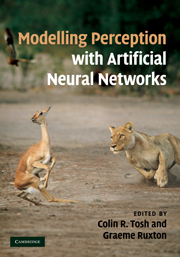Book contents
- Frontmatter
- Contents
- Contributors
- Introduction: Modelling perception with artificial neural networks
- Part I General themes
- Part II The use of artificial neural networks to elucidate the nature of perceptual processes in animals
- 3 Correlation versus gradient type motion detectors: the pros and cons
- 4 Spatial constancy and the brain: insights from neural networks
- 5 The interplay of Pavlovian and instrumental processes in devaluation experiments: a computational embodied neuroscience model tested with a simulated rat
- 6 Evolution, (sequential) learning and generalisation in modular and nonmodular visual neural networks
- 7 Effects of network structure on associative memory
- 8 Neural networks and neuro-oncology: the complex interplay between brain tumour, epilepsy and cognition
- Part III Artificial neural networks as models of perceptual processing in ecology and evolutionary biology
- Part IV Methodological issues in the use of simple feedforward networks
- Index
- References
3 - Correlation versus gradient type motion detectors: the pros and cons
from Part II - The use of artificial neural networks to elucidate the nature of perceptual processes in animals
Published online by Cambridge University Press: 05 July 2011
- Frontmatter
- Contents
- Contributors
- Introduction: Modelling perception with artificial neural networks
- Part I General themes
- Part II The use of artificial neural networks to elucidate the nature of perceptual processes in animals
- 3 Correlation versus gradient type motion detectors: the pros and cons
- 4 Spatial constancy and the brain: insights from neural networks
- 5 The interplay of Pavlovian and instrumental processes in devaluation experiments: a computational embodied neuroscience model tested with a simulated rat
- 6 Evolution, (sequential) learning and generalisation in modular and nonmodular visual neural networks
- 7 Effects of network structure on associative memory
- 8 Neural networks and neuro-oncology: the complex interplay between brain tumour, epilepsy and cognition
- Part III Artificial neural networks as models of perceptual processing in ecology and evolutionary biology
- Part IV Methodological issues in the use of simple feedforward networks
- Index
- References
Summary
Introduction
In motion vision, two distinct models have been proposed to account for direction-selectivity: the Reichardt detector and the gradient detector (Figure 3.1). In the Reichardt detector (also called ‘Hassenstein–Reichardt’ detector or correlation-type motion detector), the luminance levels of two neighbouring image locations are multiplied after being filtered asymmetrically (Figure 3.1, left). This operation is performed twice in a mirror-symmetrical fashion, before the outputs of both multipliers are subtracted from each other (Hassenstein & Reichardt,1956; Reichardt, 1961, 1987; Borst & Egelhaaf, 1989). The spatial or temporal average of such local motion detector signals is proportional to the image velocity within a range set by the detector time-constant (Egelhaaf & Reichardt, 1987). However, it is one of the hallmarks of this model that the output of the individual velocity detectors depends, in addition to stimulus velocity, in a characteristic way on the spatial structure of the moving pattern: in response to drifting gratings, for example, the local Reichardt detector output consists of two components: a sustained (DC) component which indicates by its sign the direction of the moving stimulus, and an AC component, which follows the local intensity modulation and, thus, carries no directional information at all. Since the local intensity modulations are phase-shifted with respect to each other, the AC components in the local signals become cancelled by spatial integration of many adjacent detectors. Unlike the AC component, the DC component survives spatial or temporal averaging (integration). The global output signal, therefore, is purely directional.
Information
- Type
- Chapter
- Information
- Modelling Perception with Artificial Neural Networks , pp. 63 - 73Publisher: Cambridge University PressPrint publication year: 2010
